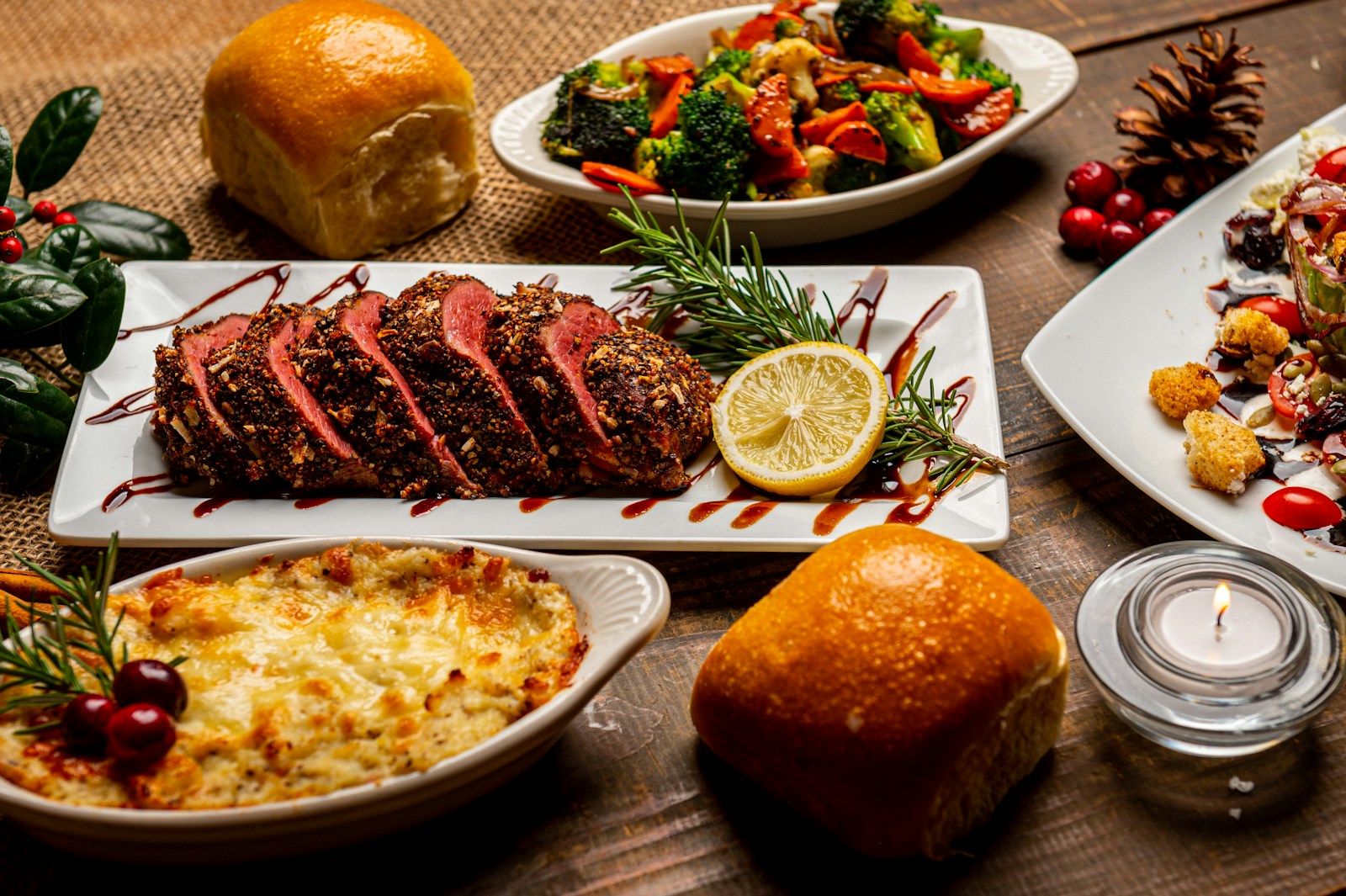To have a sustainable Christmas celebration, consider the environmental impact of every decision you make during the holiday season.
Opt for eco-friendly decorations such as reusable garlands or ornaments made from recycled materials. When it comes to hosting gatherings, choose to serve locally sourced and organic foods to reduce the carbon footprint of your festivities.
Additionally, try to minimize waste by using reusable dishware and cutlery instead of disposable options. Encourage your guests to participate in reducing waste by providing clearly labeled recycling and compost bins. By making conscious choices in all aspects of your Christmas celebration, you can enjoy the holiday season while also caring for the planet.
Eco-Friendly Gift Giving Ideas
When it comes to gift-giving during the holiday season, choosing eco-friendly options can make a significant impact on reducing waste and promoting sustainability. One idea is to opt for gifts that are made from recycled materials or are reusable, such as stainless steel water bottles or beeswax wraps. These items not only help reduce single-use plastics but also encourage a more sustainable lifestyle for the recipient.
Another eco-conscious gift-giving idea is to give experiences instead of physical items. Consider gifting a cooking class, spa day, or concert tickets to create lasting memories without contributing to unnecessary consumption. Experiences not only reduce waste but also support local businesses and bring joy to your loved ones in a meaningful and sustainable way.
How to Wrap Gifts Sustainably
Opting for sustainable gift wrapping is a thoughtful way to reduce waste during the holiday season. Consider using recycled materials such as old newspapers, brown paper bags, or fabric scraps to wrap your gifts. Not only does this approach minimize environmental impact, but it also adds a unique and personalized touch to your presents.
Another eco-friendly alternative is to reuse gift bags, boxes, and ribbons from previous occasions. By simply repurposing these items, you can give them a new life and contribute to a more sustainable gift-giving practice. Get creative by embellishing your gifts with natural elements like twine, dried flowers, or pinecones for an elegant and earth-conscious presentation.
Choosing a Real Christmas Tree Responsibly
When choosing a real Christmas tree, start by looking for local tree farms or suppliers that practice sustainable farming methods. By purchasing from local sources, you reduce the carbon footprint associated with transportation and support your community’s economy. Additionally, opt for tree farms that prioritize environmentally friendly practices such as minimal pesticide use and replanting initiatives to ensure the health and longevity of their forests.
Before making a purchase, inquire about the tree’s origins and certifications, such as being certified by programs like the Forest Stewardship Council (FSC) or the National Christmas Tree Association (NCTA). These certifications indicate that the trees have been grown and harvested responsibly, taking into account factors like soil health, water conservation, and wildlife protection. By choosing a real Christmas tree from a reputable and eco-conscious source, you can enjoy the beauty of a traditional holiday centerpiece while supporting sustainable forestry practices.
Creative Ways to Reduce Food Waste
When it comes to reducing food waste during the holiday season, thoughtful planning and mindful consumption are key. One effective way to minimize waste is by creating a detailed shopping list before heading to the store. By only purchasing what you need, you can prevent excess food from spoiling or being thrown away. Additionally, consider utilizing leftovers in creative ways to avoid them going to waste. Repurposing ingredients from one meal into another dish not only reduces food waste but also adds a unique touch to your menu.
Another strategy to cut down on food waste is by properly storing perishable items. Make sure to store fruits and vegetables in the crisper drawer and keep items like bread and baked goods in airtight containers to maintain freshness. Additionally, implementing a “first in, first out” approach in your fridge and pantry can help ensure that older items are used before newer purchases. By being mindful of expiration dates and rotating your food supply, you can effectively reduce waste and make the most out of your holiday meals.

Hosting a Green Christmas Party
When planning a green Christmas party, consider using digital invitations instead of paper ones to reduce waste. Opt for reusable or compostable dinnerware and utensils to minimize single-use plastic. Encourage guests to carpool or use public transportation to reduce carbon emissions. Incorporate sustainable decorations made from recycled materials or items found in nature.
Prioritize locally-sourced and organic ingredients for the menu to support local farmers and reduce the carbon footprint of your party. Offer vegetarian or vegan options to promote sustainable food choices. Provide recycling and compost bins to make it easy for guests to dispose of waste properly. Consider donating any leftover food to a local shelter or food bank to avoid food waste.
DIY Decorations Using Recycled Materials
When it comes to decorating your home for the holidays, utilizing recycled materials can be a creative and eco-friendly way to add a unique touch to your space. Consider repurposing old glass jars as candle holders or vases by adding some festive string lights or colorful ribbons. Not only does this help reduce waste, but it also gives your decorations a charming and rustic look.
Another fun DIY idea is to turn old newspapers or magazines into paper ornaments or garlands. Simply cut them into different shapes like stars, snowflakes, or hearts, and string them together with twine or yarn. You can even add a touch of glitter or paint for a more personalized touch. This not only adds a personal touch to your decorations but also gives a second life to materials that would have otherwise been thrown away.
Sustainable Shopping Tips for the Holidays
When shopping for the holidays, consider supporting local businesses and artisans to reduce your carbon footprint. Look for gifts that are made from sustainable materials and have minimal packaging to lower waste. Avoid buying items that will only be used once and prioritize durable, high-quality products that will last longer. Additionally, choosing to give experiences or consumables can also be a more sustainable option compared to physical goods that may end up unused or discarded.
Another tip for sustainable holiday shopping is to opt for items that promote environmental and social responsibility. Seek out products that are certified organic, fair trade, or ethically sourced to support companies that uphold environmentally-friendly and ethical practices. By making conscious choices about the products you purchase, you can contribute to a more sustainable economy and send a message to businesses about the importance of sustainability in consumer preferences.
Reducing Energy Consumption during Christmas
During the holiday season, it is important to be mindful of our energy consumption to reduce our environmental impact. One simple way to lower energy usage during Christmas is to switch to LED lights for your decorations. LED lights are more energy-efficient compared to traditional incandescent bulbs, helping to decrease electricity consumption and lower your carbon footprint. Additionally, consider using timers or sensors for your Christmas lights to ensure they are only on when needed, reducing unnecessary energy usage.
Another effective way to reduce energy consumption during Christmas is to be mindful of your heating and cooling usage. With guests coming over and ovens working overtime, the temperature inside your home can rise quickly. Instead of blasting the air conditioner, try using natural ventilation by opening windows to cool down your home. Additionally, consider lowering your thermostat a few degrees to conserve energy while still keeping your guests comfortable. By being conscious of your energy usage during Christmas, you can contribute to a more sustainable holiday season.
Donating Unwanted Items Instead of Throwing Them Away
When decluttering your home this holiday season, consider donating unwanted items instead of simply tossing them in the trash. Many people in need could benefit from items you no longer use or want. By donating clothes, household items, and toys to local charities or shelters, you can help those less fortunate while also reducing waste in landfills. Remember that one person’s unwanted item could be a treasure for someone else.
Before donating, make sure the items are clean, in good condition, and functional. This shows respect for those who will receive them and ensures that your donations will be useful. Check with local organizations to see what items they accept and any guidelines they may have for donations. Remember that your act of generosity can make a difference in someone’s life this holiday season.




